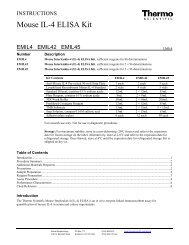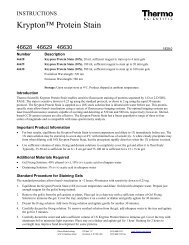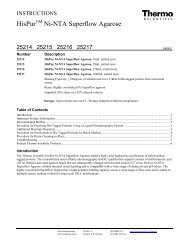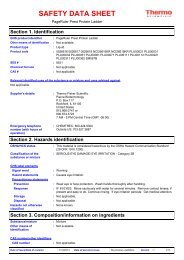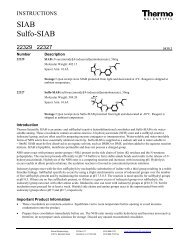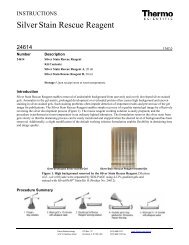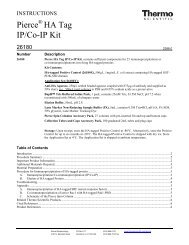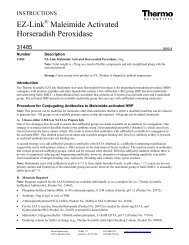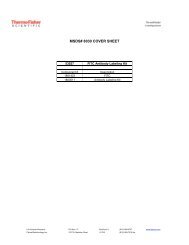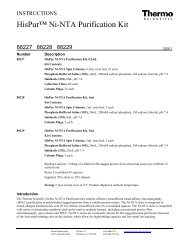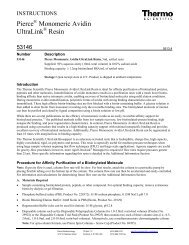Page 1 Coomassie PlusTM Protein Assay Reagent 0023238 ...
Page 1 Coomassie PlusTM Protein Assay Reagent 0023238 ...
Page 1 Coomassie PlusTM Protein Assay Reagent 0023238 ...
Create successful ePaper yourself
Turn your PDF publications into a flip-book with our unique Google optimized e-Paper software.
<strong>Coomassie</strong> Plus TM <strong>Protein</strong> <strong>Assay</strong> <strong>Reagent</strong><br />
Section 5. Fire-fighting measures<br />
Special protective actions<br />
for fire-fighters<br />
Special protective<br />
equipment for fire-fighters<br />
:<br />
:<br />
Section 6. Accidental release measures<br />
Promptly isolate the scene by removing all persons from the vicinity of the incident if<br />
there is a fire. No action shall be taken involving any personal risk or without suitable<br />
training.<br />
Fire-fighters should wear appropriate protective equipment and self-contained breathing<br />
apparatus (SCBA) with a full face-piece operated in positive pressure mode.<br />
Personal precautions, protective equipment and emergency procedures<br />
For non-emergency<br />
personnel<br />
For emergency responders<br />
: No action shall be taken involving any personal risk or without suitable training.<br />
Evacuate surrounding areas. Keep unnecessary and unprotected personnel from<br />
entering. Do not touch or walk through spilled material. Do not breathe vapor or mist.<br />
Provide adequate ventilation. Wear appropriate respirator when ventilation is inadequate.<br />
Put on appropriate personal protective equipment.<br />
: If specialised clothing is required to deal with the spillage, take note of any information in<br />
Section 8 on suitable and unsuitable materials. See also the information in "For nonemergency<br />
personnel".<br />
Environmental precautions<br />
:<br />
Avoid dispersal of spilled material and runoff and contact with soil, waterways, drains and<br />
sewers. Inform the relevant authorities if the product has caused environmental pollution<br />
(sewers, waterways, soil or air).<br />
Methods and materials for containment and cleaning up<br />
Small spill :<br />
Large spill :<br />
Section 7. Handling and storage<br />
Stop leak if without risk. Move containers from spill area. Dilute with water and mop up<br />
if water-soluble. Alternatively, or if water-insoluble, absorb with an inert dry material and<br />
place in an appropriate waste disposal container. Dispose of via a licensed waste<br />
disposal contractor.<br />
Stop leak if without risk. Move containers from spill area. Approach release from upwind.<br />
Prevent entry into sewers, water courses, basements or confined areas. Wash spillages<br />
into an effluent treatment plant or proceed as follows. Contain and collect spillage with<br />
non-combustible, absorbent material e.g. sand, earth, vermiculite or diatomaceous earth<br />
and place in container for disposal according to local regulations (see Section 13).<br />
Dispose of via a licensed waste disposal contractor. Contaminated absorbent material<br />
may pose the same hazard as the spilled product. Note: see Section 1 for emergency<br />
contact information and Section 13 for waste disposal.<br />
Precautions for safe handling<br />
Protective measures<br />
Advice on general<br />
occupational hygiene<br />
:<br />
:<br />
Put on appropriate personal protective equipment (see Section 8). Do not get in eyes or<br />
on skin or clothing. Do not breathe vapor or mist. Do not ingest. Use only with adequate<br />
ventilation. Wear appropriate respirator when ventilation is inadequate. Keep in the<br />
original container or an approved alternative made from a compatible material, kept<br />
tightly closed when not in use. Empty containers retain product residue and can be<br />
hazardous. Do not reuse container.<br />
Eating, drinking and smoking should be prohibited in areas where this material is handled,<br />
stored and processed. Workers should wash hands and face before eating, drinking and<br />
smoking. Remove contaminated clothing and protective equipment before entering<br />
eating areas. See also Section 8 for additional information on hygiene measures.<br />
Conditions for safe storage,<br />
including any<br />
incompatibilities<br />
:<br />
Store between the following temperatures: 2 to 8°C (35.6 to 46.4°F). Store in<br />
accordance with local regulations. Store in original container protected from direct<br />
sunlight in a dry, cool and well-ventilated area, away from incompatible materials (see<br />
Section 10) and food and drink. Store locked up. Keep container tightly closed and<br />
sealed until ready for use. Containers that have been opened must be carefully resealed<br />
and kept upright to prevent leakage. Do not store in unlabeled containers. Use<br />
appropriate containment to avoid environmental contamination.<br />
Date of issue/Date of revision : 10/24/2013. Date of previous issue : No previous validation. Version : 1 4/12



